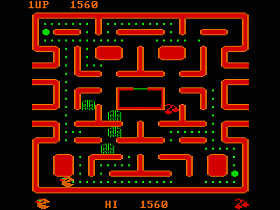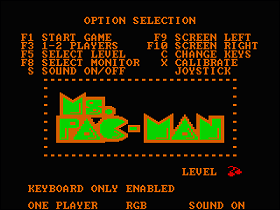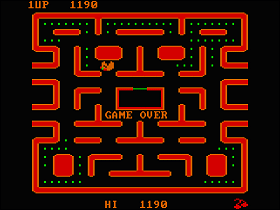 The Game: As the bride of that most famous of single-celled omniphage life forms, your job is pretty simple – eat all the dots, gulp the large blinking dots in each corner of the screen and eat the monsters while they’re blue, and avoid the monsters the rest of the time. Occasionally various fruits and other foods will bounce through the maze, and you can gobble those for extra points. (Atarisoft, 1983)
The Game: As the bride of that most famous of single-celled omniphage life forms, your job is pretty simple – eat all the dots, gulp the large blinking dots in each corner of the screen and eat the monsters while they’re blue, and avoid the monsters the rest of the time. Occasionally various fruits and other foods will bounce through the maze, and you can gobble those for extra points. (Atarisoft, 1983)
Memories: The early days of the IBM PC – which had, at this point, been on the market for two years – saw numerous software publishers trying to second-guess the PC’s position in the market. IBM’s a tech giant for businesses, but will this thing take off in the consumer market? If so, do we market entertainment software for it? Is it even suited to that sort of thing? And the answer to those questions, in 1983, was…well, maybe?
 The biggest hindrance to early PC gaming was, perhaps, IBM putting its business mission statement into hardware form. The IBM PC had little in the way of native sound or graphic capabilities, because, in IBM’s opinion, it was there to run spreadsheets, which required none of that. The best graphics PCs could muster in those days were those from the Color Graphics Adapter (CGA), whose color palette was, perhaps, not exactly sunny. The bright colors of Ms. Pac-Man, for example, become muted earth tones at best. Resolution-wise, a PC equipped with CGA graphics had the necessary hardware to accurately put a Ms. Pac-Man maze on the screen, but the day-glo cheeriness of the original arcade game was gone.
The biggest hindrance to early PC gaming was, perhaps, IBM putting its business mission statement into hardware form. The IBM PC had little in the way of native sound or graphic capabilities, because, in IBM’s opinion, it was there to run spreadsheets, which required none of that. The best graphics PCs could muster in those days were those from the Color Graphics Adapter (CGA), whose color palette was, perhaps, not exactly sunny. The bright colors of Ms. Pac-Man, for example, become muted earth tones at best. Resolution-wise, a PC equipped with CGA graphics had the necessary hardware to accurately put a Ms. Pac-Man maze on the screen, but the day-glo cheeriness of the original arcade game was gone.
 The game play itself is adequate; keyboard controls are configurable, so players can use the obvious arrow keys or – as was not uncommon in the early 1980s – use a more familiar cluster (WASD, IJKM, etc.) of keys to control the game.
The game play itself is adequate; keyboard controls are configurable, so players can use the obvious arrow keys or – as was not uncommon in the early 1980s – use a more familiar cluster (WASD, IJKM, etc.) of keys to control the game.
As crude as it may seem from the standpoint of the early 21st century, this is what PC gaming was like in the early days. Now, of course, we can fire up an evolved variant of the same PC for which this game was  intended, and play the original arcade code in emulation. But in the 1980s, when approximating arcade controls, game play and graphics was all but a pipe dream for home consoles and computer systems, this is what it was like: not great, but not absolutely terrible either.
intended, and play the original arcade code in emulation. But in the 1980s, when approximating arcade controls, game play and graphics was all but a pipe dream for home consoles and computer systems, this is what it was like: not great, but not absolutely terrible either.